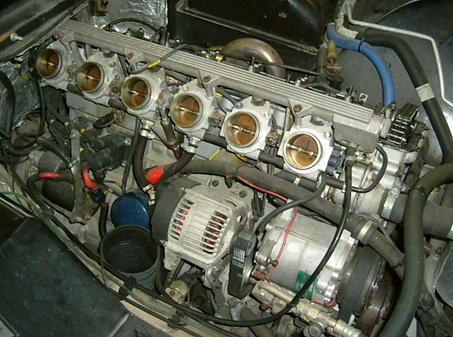
TVR
TUSCAN
This car arrived sounding very unwell, suffering a misfiring, rough running engine, which badly needed some investigating. It was duly installed in the workshop and various checks were carried out commencing with compression checks and cylinder leakage checks. This was to ascertain whether it was a mechanical fault or electronic. All the checks proved to be successful but I still had to make sure the fragile finger followers were in good working order. These engines are renowned for the followers failing which can be catastrophic if it goes undetected. It usually manifests itself as a misfire which is exactly what I had, so I had to make sure nothing was untoward. Thankfully all was well.

These follower checks involved removing the cam cover to gain access to the camshaft assemblies. Thank goodness I did as the amount of excess sealant inside the engine was worrying to say the least. Apparently the engine had been worked on by a TVR dealer who had made an awful mess of putting it back together. The air box was broken with a vacuum take off missing and one of the vacuum pipes hanging loose not connected to anything. Clearly this wasn’t going to aid the smooth running issue, but after scoping the ignition system, it turned out to be a damaged ignition lead which was fairly straight forward to replace. The excess sealant in the engine had worked it’s way round to the oil tank strainer on the return oil pipe and had started to block the mesh. This would almost certainly restrict the flow of oil from the engine, so it was removed and cleaned.
I had a set of performance ignition leads made for the car by Magnecor which would sort the misfire out. The engine was put back together with a new oil pressure release valve spring and once completed ran perfectly.


Cylinder leakage checks in progress. This process shows any faults with piston rings or bores, valves not seating or damaged and cylinder head gasket failure. Fortunately no problems were found with this engine.
Compression checks being carried out.

The cam cover removed to allow an inspection of the camshafts and followers. You can see clearly in this shot the excess sealant around the mating surface on the top of the cylinder head. Some of this had found it’s way round to the oil return pipe strainer in the oil tank. This would almost certainly impair the flow of oil around the system, so the strainer was removed and cleaned.

The oil strainer cleaned and ready to be refitted

The air box assembly removed to gain access to the oil filter and coil pack to replace the ignition leads.

Removing the excess sealant from the cam cover.

The cam cover dressed and cleaned, looking like new again.


The camshaft and followers coated in assembly lube to stop and damage occurring on initial start up to the cam lobe surfaces.

The cam cover refitted, still awaiting the ignition lead spacers which locate on the spark plug holes secured with RTV sealant.

A custom made set of high performance ignition leads for the Speed 6 engine, a beautiful quality product that makes all the difference.



The ignition leads fitted and the cover installed. More sealant is applied around the cover to make sure it’s water tight.



The left hand video, shows the bronze bar being machined to size. Here the part that will become the threaded section, is being turned to a diameter of 22mm, before being screw cut with the new thread.
On the right, the hexagonal part of the plug is being made, the part set up on the rotary table, which makes the process straightforward.
Once the hexagonal part is completed, the piece is put back in the lathe, for the thread to be screw cut. This is shown below, and the finished plug fitted to the block.

